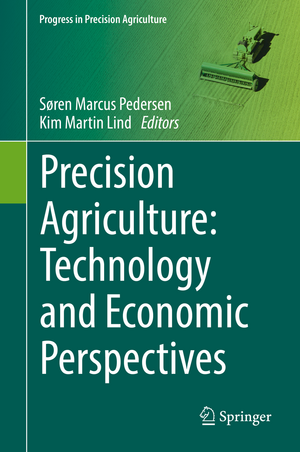Precision Agriculture: Technology and Economic Perspectives: Progress in Precision Agriculture
Editat de Søren Marcus Pedersen, Kim Martin Linden Limba Engleză Hardback – 29 noi 2017
| Toate formatele și edițiile | Preț | Express |
|---|---|---|
| Paperback (1) | 1148.09 lei 38-44 zile | |
| Springer International Publishing – 6 sep 2018 | 1148.09 lei 38-44 zile | |
| Hardback (1) | 1439.70 lei 38-44 zile | |
| Springer International Publishing – 29 noi 2017 | 1439.70 lei 38-44 zile |
Preț: 1439.70 lei
Preț vechi: 1894.34 lei
-24% Nou
Puncte Express: 2160
Preț estimativ în valută:
275.52€ • 299.17$ • 231.44£
275.52€ • 299.17$ • 231.44£
Carte tipărită la comandă
Livrare economică 19-25 aprilie
Preluare comenzi: 021 569.72.76
Specificații
ISBN-13: 9783319687131
ISBN-10: 3319687131
Pagini: 280
Ilustrații: XII, 276 p. 50 illus., 34 illus. in color.
Dimensiuni: 155 x 235 mm
Greutate: 5.55 kg
Ediția:1st ed. 2017
Editura: Springer International Publishing
Colecția Springer
Seria Progress in Precision Agriculture
Locul publicării:Cham, Switzerland
ISBN-10: 3319687131
Pagini: 280
Ilustrații: XII, 276 p. 50 illus., 34 illus. in color.
Dimensiuni: 155 x 235 mm
Greutate: 5.55 kg
Ediția:1st ed. 2017
Editura: Springer International Publishing
Colecția Springer
Seria Progress in Precision Agriculture
Locul publicării:Cham, Switzerland
Cuprins
Chapter 1 Precision Agriculture – from Mapping to Site-specific Application.- 1.1. Introduction.- 1.2 Current PF technologies.- 1.3 Variable rate application.- 1.4 Adoption of precision farming systems.- 1.5 The aim and organisation of this book.- 1.6 Summary and main findings.- Chapter 2 Smart Farming Technologies – Description, Taxonomy, Economic Impact.- 2.1. Precision Agriculture as a cyclic optimisation process.- 2.2. Smart Farming Technologies Types.- 2.3. Smart Farming Technologies Taxonomy.- 2.4. Smart Farming Technologies economic impact.- Chapter 3 Economic potential of site-specific fertiliser application and harvest management.- 3.1. Introduction.- 3.2. Framework for economic assessment.- 3.3. Analysis of studies.- 3.3.1 Site-specific nitrogen fertilization.- 3.4 Site-specific management with respect to crop quality.- 3.4.1 Site-specific nitrogen management with respect to protein concentration.- 3.4.2 Site-specific harvest management (Grain segregationby protein concentration).- 3.5. Conclusions.- Chapter 4 Economics of site specific and variable rate herbicide application.- 4.1 Introduction.- 4.2 Application technologies.- 4.3 Planning and low dose DSS.- 4.4 Weed Detection.- 4.5 Conclusion.- Chapter 5 The Economics and Perspectives of Site Specific Irrigation Management in Australia.- 5.1. Introduction.- 5.2. Irrigation and cotton growing in Australia.- 5.3. Cotton Nutrition and Managing Nitrous Oxide Emissions.- 5.4. Method of analysis.- 5.5. Results.- 5.6. Discussion.- 5.7. Conclusions.- Chapter 6 Auto-steering and Controlled Traffic Farming – Route planning and economics.- 6.1 Introduction.- 6.2 Route planning design.- 6.3 Results.- 6.4 Conclusion.- Chapter 7 Profitability of controlled traffic in grass silage production.- 7.1. Introduction.- 7.2. Machinery system design.- 7.3. Problem definition.- 7.4. A model for economic evaluation of CTF.- 7.5. Results.- 7.6. Discussion.- 7.7. Conclusions.- Chapter 8 Robotic seeding – economic perspectives.- 8.1 Introduction.- 8.2 Economic performance.- 8.3 Robotic system for crop seeding.- 8.4 Economic assessment of early seeding and re-seeding with robots in sugar beet.- 8.5 Early seeding.- 8.6 Re-seeding.- 8.7 Creating re-seeding maps with UAVs.- 8.8 Results.- 8.9 Sensitivity analysis.- 8.10 Conclusions.- Chapter 9 Future perspectives of Farm Management Information Systems.- 9.1 Introduction to Farm Management Information Systems.- 9.2 Farm management information systems functionalities and applications.- 9.3 Costing functionalities of FMIS.- 9.4 Adoption of FMIS.- 9.5 Discussion and conclusions.- Chapter 10 Sustainable intensification in crop farming – a case from Estonia.- 10.1 Introduction.- 10.2 Material and method.- 10.3 Results.- 10.4 Discussion.- 10.5 Conclusion.- Chapter 11 How to model the Adoption and Perception of Precision Agriculture Technologies.- 11.1. Introduction.- 11.2. Theoretical Models.- 11.3. Behavioural models and their application in Agricultural Sciences.- 11. 4. Discussions and conclusion.- Chapter 12 Perspectives of Precision Agriculture in a Broader Policy Context.- 12.1 Introduction.- 12.2 PA and wider societal trends.- 12.3 Policy trends in Europe.- 12.4 Stakeholder involvement.- 12.5 Opportunities for small and medium size companies.- 12.6 Concluding remarks.- Abbreviations and glossary.- List of Authors.- Index.
Textul de pe ultima copertă
This book presents cases from different countries with a main focus on the perspectives of using precision farming in Europe. Divided into 12 chapters it addresses some of the most recent developments and aspects of precision farming. The intention of this book is to provide an overview of some of the most promising technologies with precision agriculture from an economic point of view. Each chapter has been put together so that it can be read individually should the reader wish to focus on one particular topic. Precision Farming as a farm technology benefits from large-scale advantages due to relatively high investment costs and is primarily adopted on farms with medium to large field areas.
The book is intended for readers who have an interest in precision farming and the economic potential for applying modern technology in arable farming. The book will provide a broad economic and technical insight into the area of advanced farming and cropping systems.
The book is intended for readers who have an interest in precision farming and the economic potential for applying modern technology in arable farming. The book will provide a broad economic and technical insight into the area of advanced farming and cropping systems.
Caracteristici
There is a void of books on the economics of precision agriculture, no similar books have been published A farm business management mental framework of approach lends itself to a broad target audience from practitioners to research scientists The book organization will parallel the steps of the decision-making process and use illustrative example cases to emphasize how a farmer considering precision agriculture technology would think Includes supplementary material: sn.pub/extras



